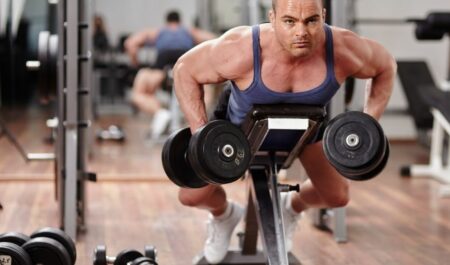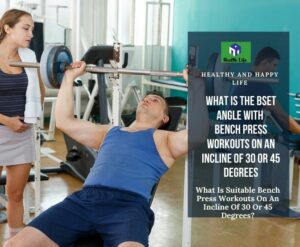According to scientific studies, using an incline bench to grow your upper chest muscles at a 45-degree slope is more advantageous than using one at a 30-degree angle for the same purpose. Although many believe that the 45-degree angle is unfavorable because it recruits the anterior deltoid muscles rather than the pecs, the truth is that. In addition to increased shoulder activation, you also receive improved upper pectoral engagement with this position. When you’re in the gym, set your incline bench to 45 degrees the next time you go.
What Are The Objectives Of The Incline Bench Press Exercise?

The goal of the incline bench is to target the upper portion of your pecs and triceps. The “clavicular head” of the pectoralis major refers to this region of the muscle. Clavicular head is so named because it is the point at which the pec muscle joins to the clavicles of the body (collarbones). While we know that the flat bench activates a substantial portion of the chest muscle, including the sternocostal head (the point at which the pec joins to the sternum). We also know that it does a poor job of stimulating the upper pec muscle. For the same reason, the decline bench trains the bottom half of the chest while neglecting the top portion.
- The sternocostal pectoral head and the center section of the chest are the primary focus of the flat bench.
- The decline bench is a chest exercise that targets the lower region of the pectoral muscles.
- The upper region (clavicular head) of the pecs should receive the majority of the attention during pec growth on an incline bench.
- We will choose the ideal incline bench press angle depending on which one offers the greatest amount of muscle. It is an activation to the clavicular pectoral head during the exercise.
Considering that the flat bench and decline bench do not engage the upper chest. It is up to the incline bench press exercise to recruit the clavicular head of the pectoral muscle during the activity. With this in mind, we’ll determine which incline bench press angle is the most beneficial. It is based on which one successfully works the upper chest the most effectively.
In What Degree Of Incline Does The Bench Provide The Most Effective Upper Pec Workout?
Activation of the pectoral muscles was assessed in a scientific study published in the Journal of Strength and Conditioning Research at four different bench press angles. The angles were as follows:
- 0 degrees (flat bench),
- 28 degrees incline,
- 44 degrees incline, and
- 56 degrees incline (in that order).
When athletes bench pressed at a 44-degree slope, they had the greatest muscle activation of the clavicular pectoral head (clavicle). Benching at 44 degrees incline resulted in a 42 percent increase in clavicular head activation when compared to benching at a 28-degree incline. Because 44 degrees and 28 degrees are equivalent to 45 degrees and 30 degrees, we may infer that a 45-degree incline bench is more effective than a 30-degree incline bench at working the upper chest.
- According to scientific study, a 44-degree incline bench is more effective at activating the upper region of the chest than a 28-degree elevation.
- Thus, a 45-degree incline is more efficient for upper chest training than a 30-degree elevation for upper chest training.
- When it comes to stimulating your clavicular pectoral head, a 30-degree incline bench is less effective than a 45-degree incline bench.
Incline angles close to 30 degrees provide middle-of-the-road muscular activation for both the clavicular head and the sternocostal head of the pectoral muscle when performed on an inclined surface. When it comes to targeting specific areas of the chest, the flat bench and 45-degree bench are superior.
According to the findings of this study, while the 28-degree bench press engaged the sternocostal head of the pectoralis major more effectively than the 44-degree bench press. It was less successful than a flat bench press at this activation. Consequently, the 30-degree incline bench falls into a no-land man’s where it fails to engage the middle of your chest in the same way. And that flat bench does while also failing to activate the upper chest in the same way that a 45-degree incline bench press does.
What Is The Proper Way To Set Your Incline Bench Press To The Proper Angle?
Now that we know that a 45-degree angle is better for your upper chest than a 30-degree angle. How do we properly arrange our bench for the best possible results? But, there’s no need to bring a protractor to the gym, so don’t be concerned. Setting your adjustable bench at an angle and then measuring the angle with your iOS or Android device is as simple as that. You’ll obtain the correct angle every time if you do it this way.
- Make use of the built-in Measure app on your iPhone to determine the angle of your adjustable bench.
- Use this Android application to determine the angle of your incline bench.
- Adjust the angle of your bench press to 45 degrees for the most effective upper chest training possible.
After you’ve set up your incline bench press a few times, you’ll quickly recall the exact settings. And that you need to achieve the desired angle. This will ensure that you get the best upper chest activation possible during bench press. That will allow you to increase your total chest size and strength.
Is It True That Incline Bench Helps To Build Shoulders?
The incline bench press is a fantastic exercise for strengthening your shoulder muscles. A 45-degree incline bench angle, in addition to offering the highest engagement of the upper pecs. And also it gives a more intense workout for your anterior deltoids (the muscles on the front of your shoulder) than a flat bench or a 30-degree incline.

- In comparison to flat or shallow-incline bench press, it is performing an incline bench press at the appropriate angle for upper chest. Its engagement trains your shoulders more.
- Take advantage of the incline bench press as a great way to engage your upper chest. And it is also anterior deltoid muscles simultaneously.
While some people believe that you should avoid engaging your shoulders on the incline bench. The truth is that the best angle for upper chest growth also engages your anterior deltoids and triceps. The two are inextricably linked and cannot be separated. To get the most out of the incline bench, change your perspective and consider it a hybrid upper chest/shoulder workout.
Exactly What Angle Should You Have Your Incline Bench Press Set At?
The research is complete, and the mystery of the optimal incline bench angle has been answered. Here are the facts of the situation.
- A 45-degree elevation is more effective than a 30-degree incline in terms of activating the upper chest muscles.
- Because flat and decline benches are more effective at exercising different parts of your chest. And use your incline bench to concentrate on the upper chest muscles only.
- At a 45-degree incline, you will increase the emphasis on your shoulders, but the tradeoff is improved upper chest growth.
Final Thought
The next time you set up your bench press for an incline, take a picture with your phone to record the angle. Keep in mind that if you want to concentrate on developing the upper half of your chest, an incline bench press at 45 degrees is the optimal angle to use.
